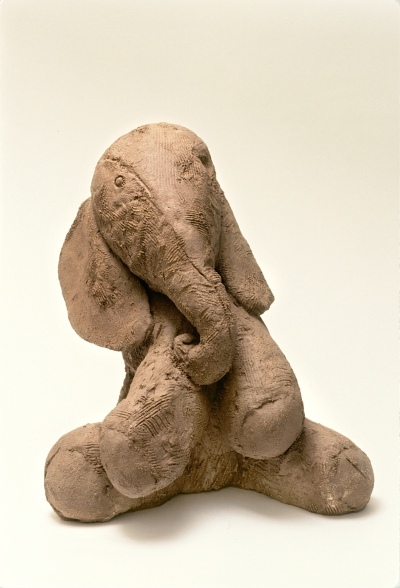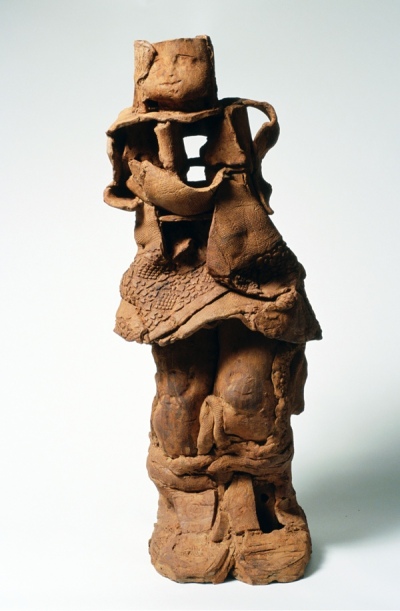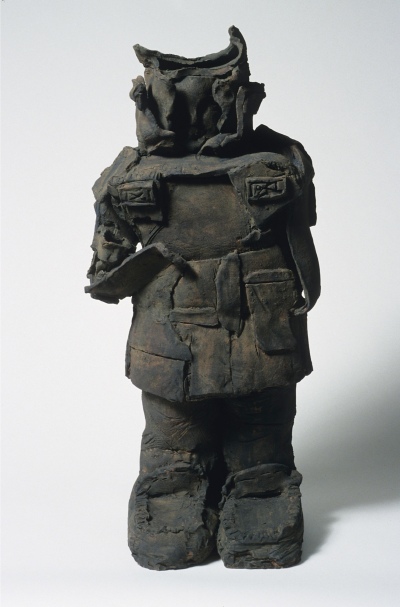Gail Goldsmith has been creating figurative clay sculpture for more than 20 years. Her subject matter has sources in children’s toys, portrait faces, and in memory. Her sculptures convey a wide range of emotions. Gail Goldsmith has exhibited extensively in New York and New England.
When did you start doing art?
I was ten years old and my family was living in Los Angeles with my aunt. I was given a drawing book, which showed how to turn letters of the alphabet into faces. This fascinated me; I sat on the living room floor for hours making pencil drawings. My aunt said that she wanted to send me for art lessons. At that moment I realized I would be an artist.
What do you do? Tell us about your art.
Almost all of my work is based on the human figure. (The “Everyday Weapons” series you saw is a prominent exception!). I started out as a painter, drawing from models. Then when I was at Cranbrook Academy of Art, I began working with clay, doing small clay figure studies. After graduating I continued with pieces that are abstracted from the human figure. I have worked in a range of sizes from six inches to six feet. I have developed many techniques for working in clay in addition to the typical techniques of modeling and slab building. I have made plaster molds into which the clay can be pressed and the resulting forms combined into sculptures and other ways of working with molds. Another technique is imprinting clay slabs with fabric or other patterns as it rolls through a slab roller. Sometimes my sculptures are constructed in sections either to make larger work or to make the finished piece (clay sculptures get quite heave) easier to handle. Starting perhaps fifteen years ago, I also make collages of paper images. When I do this, I keep a piece on my drawing table and move the papers around, often stopping while walking by.
Is it difficult as a woman in the industry? Can you give us examples/personal experiences?
It’s difficult for everyone in this industry. I think of a friend who was never able to get a gallery to take her paintings seriously; always they said, “You’re just going to get married and have children.” She was so discouraged that she quit. At that time I remember showing slides to a director who shrugged his shoulders, “I don’t know – I just don’t like them.” I don’t know if this had anything to do with being a woman, but I suspect that it did.
How do you overcome these difficulties?
It’s always been difficult. Anyway I am very persistent and have learned to follow up on whatever comes my way.
What’s the best thing about being a woman artist? Are there any advantages that only women have?
The best thing about being a woman artist? Friendships with other women artists. Possibly women are more intuitive and/or more willing to explore their intuitive feelings.
Elephant, 22 x 18 x 17 in.
You mentioned that a lot of your work references children and memory, what inspires you to work with these themes? How does your work communicate these themes to the audience?
I had started working on a genealogy and had carried off a large box filled with unsorted photos, several generations of children including many of my brother and me. I used a copying machine, cut and rearranged the images. These images still speak to me. It seems to me that all of us wonder about our lives, how we got from there to here. Also I believe that every work of art that I make can speak to some person, though not necessarily to everyone, and that part of what I do is to try to find that person or persons.
Have you ever considered using a medium other than clay? Have you experimented with other sculptural media?
When I was a student traveling in Italy, I found classes for artisans that taught the basic techniques of carving in stone and in wood. From time to time I have done some carving, especially using driftwood logs from the beach. I have also done some casting in iron and in bronze. Right now I am working with cut pieces of crumpled paper.
Tell us about the process of making a new piece.
That is a difficult question because the process can vary. I might start from a toy or object that interests me and build the form with large slabs of clay (the larger sculptures must be hollow). Sometimes with small pieces I pinch and twist a piece of clay until it suggests something. There is a series of standing figures which started with large clay shoes. I didn’t know the form the figure would take until it revealed itself to me.
What is your favorite piece/project?
A favorite project is titled “Grandmother’s Apron.” It’s a series of eleven pieces which originated from a single sculpture based on my grandmother’s Russian doll. If I have to choose one single sculpture, it would be “Spiritual Warrior.” This piece, 34” tall, was created with techniques of hand-building and improvisation within the possibility of what the clay could and would do.
Grandmother’s Apron #6, 25” x 18” x 19”
What was the proudest/most memorable moment of your career?
The opening night of my exhibition at the New York Studio School of Drawing, Painting, and Sculpture in November of 2011. The School showcased a range of my work from early in my career to the present time. The School curated and installed the twenty pieces. When I walked in and could see what I had accomplished, I myself was astonished.
Pandora, 38 x 11.5 x 13 in.
What are your future plans? Do you have any new project coming up?
I have started a new body of work, using pieces of cut paper and building on my lifetime relationship to the figure. I hope to find an audience for these and for my earlier work.
What is your dream project?
Hmmm – – – a great many. an outdoor large elephant, based on my clay elephant. To live another fifteen years and have another retrospective. To turn my studio into an exhibition place for my artist friends.
What does art, making art, mean to you and how does it affect your life?
Being an artist is my identity; it is me, who I am. As a young girl, I felt that I had something to say. Now I feel that I have many things to say. I live in a loft/studio with my work around me. When I travel, I look for locations to feed the spirit of my work. At times that I am between bodies of work, starting something new, I can feel lost, outside my real self. Then I walk along the ocean and find the confidence to continue.
Spiritual Warrior, 35” x 16” x 12”





